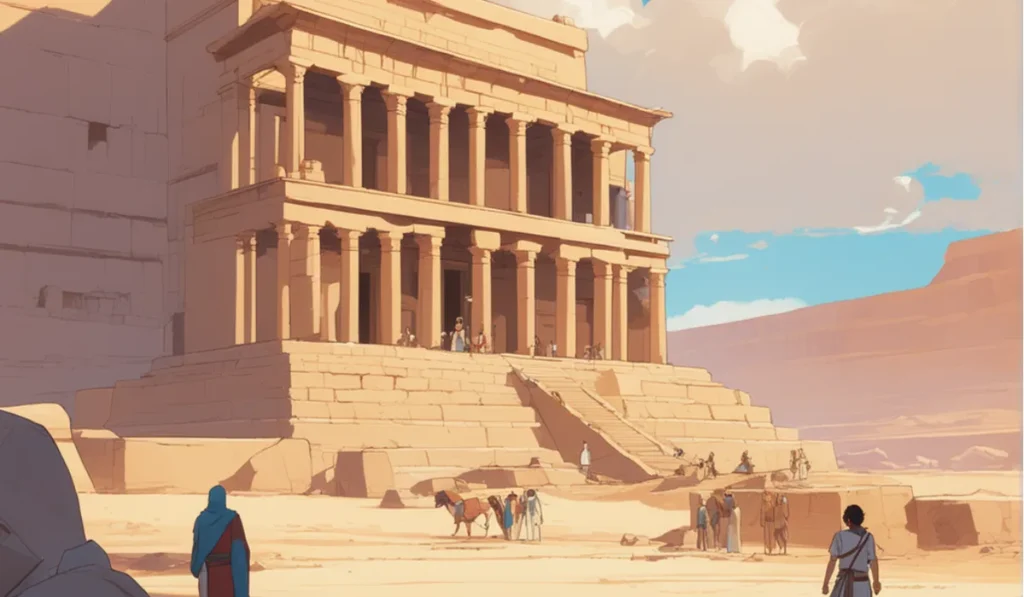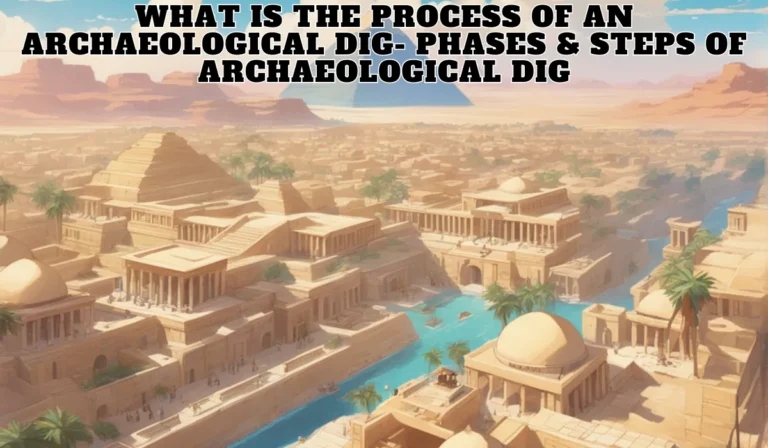Hey there, curious minds! Ever wondered What is the Process of an Archaeological Dig and How we dig up the past? Well, let me take you on a journey through the fascinating process of an archaeological dig. It’s like unwrapping a time capsule!
You know, the Process of an Archaeological Dig Contains various phases & Steps of archaeological dig and the past is a puzzle waiting to be solved. Archaeologists dive into the ground to uncover bits of history – from ancient tools to forgotten stories.
Hey, I promise by the end of this blog, you’ll understand Process of an Archaeological Dig and How archaeologists turn dust into history books!
Before we start digging, we gear up with research and tools. Think of it as preparing for an epic adventure.

What is the Process of an Archaeological Dig? Step by Step | What are the different stages of an archaeological excavation?How Does an Archaeological Dig Work?
Okay, how about we jump into the bare essential and Process of an archaeological dig! This is a breakdown of the way we take care of business revealing history and An archaeological dig’s procedure is described below:
Step 1: Preliminary Research
You know how detectives gather clues before cracking a case? Well, we’re like history detectives! Here’s what we do before we start digging:
- Reviewing Historical Documents: We scour old maps, photos, and written stories to understand what we’re getting into. It’s like reading a mystery novel before the big reveal.
- Aerial Surveys: Think of this as our bird’s-eye view. We fly planes, helicopters, or drones to spot sites from above. Sometimes, what’s hidden to us on the ground is crystal clear from the sky.
- Ground-Penetrating Radar Surveys: This is like our X-ray vision. We use special tools to map what’s below the surface – walls, pits, and all kinds of buried secrets.
Step 2: Excavation
Presently, we focus in and begin digging! Envision it’s a monster puzzle, and we’re assembling the pieces, each layer in turn:
- Setting up the Site: Before the real digging starts, we get things organized. We set up camp, create a grid system, and make sure we’re safe.
- Excavating the Site: It’s time to get our hands dirty! We use shovels, trowels, and screens to gently remove soil and uncover treasures. Every artifact and feature gets its moment in the spotlight.
- Analyzing Artifacts and Features: Once things are out of the ground, we give them some attention. We clean them up, figure out how old they are, and try to understand what they were used for.
Step 3: Post-Excavation
We’re not finished at this point! After the digging, there’s a ton of work to do:
- Cleaning and Conserving Artifacts: Just like cleaning up after a party, we make sure our artifacts are spick and span. We wash them, let them dry carefully, and even use some special tricks to keep them strong.
- Analyzing Data: We’re like detectives putting together clues. We take a close look at where things were found, how they relate to each other, and even use some fancy computer magic to figure things out.
- Writing Reports: Remember those mystery novels? Well, we write our own versions – detailed reports about what we found. These reports are like sharing our adventure with the world.
Archaeological digs might seem like a long journey, but every step is important. By piecing together artifacts and understanding their context, we’re like time travelers unlocking stories from the past.

What are the different types of archaeological digs?
Okay, how about we jump into the captivating universe of archeological digs! I’m here to let the cat out of the bag on the various kinds and how they work.
- Surveys: Picture us as detectives on a treasure hunt! Surveys are like our magnifying glass, helping us spot archaeological sites. We’ve got tricks up our sleeves like aerial photography, ground-penetrating radar, and even magnetometry.
- Test Pits: Imagine we’re peeking into a present’s wrapping paper before the big reveal. Test pits are like our sneak-peek holes, giving us a taste of what’s below the surface. We use them to measure depths, spot artifacts, and figure out the lay of the land.
- Full Excavations: This is the grand stage! Think of it as uncovering secrets layer by layer. It’s like peeling back the pages of history, revealing artifacts, structures, and clues about ancient life.
- Rescue Excavations: We’re like history’s heroes! Rescue excavations kick in when sites are in danger – think development or natural disasters. We swoop in to save the day and unearth as much history as possible.
- Experimental Archaeology: We’re time-travelers with a twist! In experimental archaeology, we recreate past technologies and ways of life. It’s like getting in a time machine and trying out ancient techniques ourselves.
- Virtual Archaeology: Think of this as our magic wand! Virtual archaeology uses computers to create virtual models of sites. It’s like exploring ancient places without leaving our chairs – great for dangerous or hard-to-reach spots.
The type of dig we choose depends on what we’re after and what tools we’ve got in our archaeological toolkit. Sometimes, we start with a survey to locate a site, then dig deeper with a full excavation. And when danger’s on the horizon, rescue excavations come to the rescue!
No matter what kind of dig we’re doing, we’re like meticulous documentarians. We take notes, snap photos, and draw maps to capture every moment. It’s like creating a scrapbook of history, ensuring that future generations can learn from our amazing discoveries.

What are the different methods of Archaeological excavation?
Sure thing, let’s chat about the excavation methods archaeologists use. It’s like having a toolbox loaded with various devices for various positions. This is what’s in our tool stash:
- Shovel and Trowel: Think of this as our trusty go-to. Just like gardening, we use shovels and trowels to gently scoop away soil and unveil the past. It’s perfect for smaller digs or when we’re just testing the waters.
- Screening: Ever panned for gold? Screening is like that! We pass soil through a mesh to catch tiny artifacts that might slip through the cracks. It’s like a treasure hunt in slow motion.
- Water Jetting: This is our modern-day twist. With a powerful water jet, we delicately blast away soil around artifacts. It’s like precision cleaning without the mess – perfect for keeping fragile artifacts safe.
- Geophysical Survey: Imagine us as detective scanners! Using radar and magnets, we map what’s hiding below the surface without actually digging. It’s like creating an X-ray of the ground.
- Remote Sensing: This is like using satellites for sneak peeks. We take aerial photos or use satellite images to spot surface features, like ancient mounds or hidden walls.
The method we choose depends on what we’re aiming for and what tools we have at hand. For instance, if we’re digging up a small household site, the trusty shovel and trowel might be our partners. When we’re after tiny treasures, we bring in screening to catch them. And for those big city digs, water jetting helps us work on a larger scale. Geophysical survey and remote sensing are like our magic spells to discover buried secrets before we even start digging.
But guess what? No matter which method we use, we’re like meticulous historians. We jot down notes, snap photos, and make maps – it’s like creating a time capsule of our discoveries. This documentation isn’t just for us; it’s like sharing our excitement with the world and preserving history for generations to come.
ALSO READ – 1 week or Months – How Long Is Dig Season In Egypt – Dig Season In Egypt
A Sneak Peek into Dating Techniques
Ever wondered how we figure out how old things are? We’ve got a few tricks up our sleeves:
| Technique | How It Works |
|---|---|
| Radiocarbon Dating | Measures carbon-14 decay in stuff that used to be alive |
| Stratigraphy | Checks out layers to guess ages |
| Dendrochronology | Counts tree rings to tell time |
| Thermoluminescence | Counts trapped electrons in pottery and rocks |
Being part of an archaeological dig feels like being a history detective. It’s a chance to chat with the past, even if it’s just through old bits and pieces.
Wrapping Up
Archaeological digs are like opening a window into the past. It’s not just about Process of an Archaeological Dig, it’s about bringing history back to life.Embarking on an archaeological journey feels like stepping into a time machine, uncovering the forgotten stories of our ancestors. Picking the right dig sites involves historical research, high-tech tools, and insights from the community.
Delicately unearthing artifacts feels like opening a treasure chest while safeguarding their integrity. The challenges, like funding and preserving sites, can be daunting, but teaming up with technology and engaging the public brings a sense of promise. Every artifact we unearth adds a puzzle piece to our history, ensuring the enigma of our past endures for those yet to come.
If you’re itching to join the adventure, you could volunteer on a dig or support these projects. Imagine being part of the team that pieces together history’s puzzle!
So, there you have it, a journey through the exciting process of an archaeological dig. Isn’t it amazing how dirt and dust can hold so many stories? Let’s keep exploring together!
FAQs
Can I actually join an archaeological dig as a volunteer?
Absolutely! Many archaeological projects welcome volunteers to dive into the excitement firsthand.
How do we know the age of the artifacts?
Using scientific methods like carbon dating, we estimate the age based on the material’s decay.
What’s the coolest Artifact you’ve at any point found?
Gracious, that is an extreme one! Each relic or Artifact has its own appeal and story, making it hard to pick a number one.
Is archaeology all about digging up ancient cities?
Not at all! Archaeology can focus on various aspects, from ancient cities to everyday objects, revealing diverse slices of history.
Can technology really replace traditional archaeological methods?
Technology complements traditional methods, enhancing our ability to explore history in ways we never could before.
